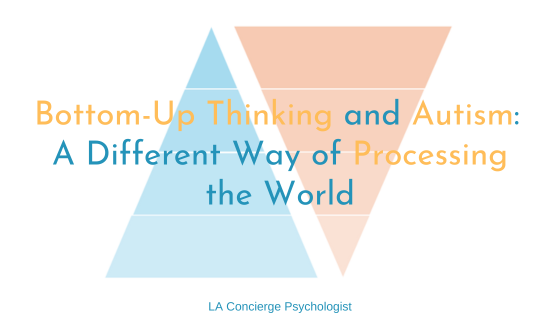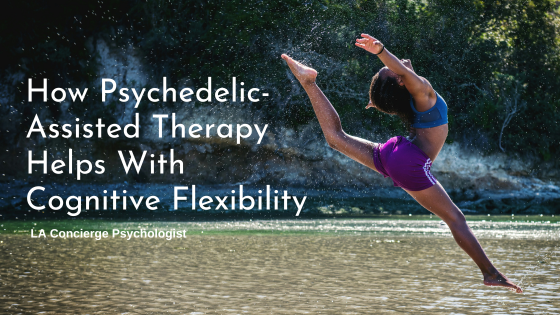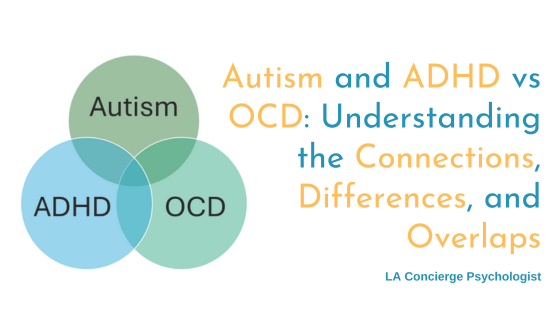You may have heard the terms “introvert” and “autistic” used interchangeably before — they’re often mixed up, so many people don’t know the difference at all. Because of this lack of clarity, it’s not unusual for someone to wonder if they’re just shy before realizing they’re actually autistic. Many autistic people realize they’re actually extroverted once they make the necessary accommodations for themselves. There are a lot of widespread misunderstandings between the two, and it’s important to understand the differences so people can advocate for themselves in social settings, understand themselves better, and even pursue an autism assessment.
Introverts tend to feel recharged by alone time and can get drained from too much social stimulation. According to one study, around 25 – 40% of the population identifies as introverted[1]. It’s not that they dislike people. Many introverts still crave social connection. They just need those quiet moments to recharge their batteries.
Autism, on the other hand, is a neurotype that about 1% of people have. People with this neurotype experience the world differently than neurotypical people. It can involve differing social norms and an extreme sensitivity to sensory input. A study found that nearly 90% of autistic people experience some form of sensory hypersensitivity[2]. For many autistic individuals, social situations can be straight-up overwhelming. They may have to withdraw and take time to recharge even if they genuinely want to connect with others.
In this article, we’ll discuss introversion and autism in more detail, examine how they differ, and offer some coping strategies for autistic people.
What Does Introversion and Extroversion Mean?
From a psychological standpoint, extroversion and introversion are personality traits that describe where individuals derive their energy and how they approach the world around them. They are part of the “Big 5” personality traits, a personality model widely backed by research (unlike the Myers-Briggs Type Indicator (MBTI)[3]).
Extroverts tend to gain energy from the external world— socializing, sensory stimulation, and action. They often feel energized by social situations and enjoy socializing in large groups. However, they may struggle with too much alone time, experiencing restlessness or a sense of unfulfillment. Extroverts thrive on external stimuli and tend to process their thoughts and emotions through open expression and engagement with others.
Conversely, introverts usually derive energy from their inner experiences – reflection, imagination, and solitude. While they may enjoy and even crave social interaction, introverts require periods of quiet and solitude to recharge their batteries. They often prefer socializing in smaller groups and tend to process their thoughts and emotions internally before expressing them outwardly. They may find excessive external stimulation draining or overwhelming. While introverted people are sometimes labeled shy and lacking self-confidence, this isn’t the case.
It is important to understand that extroversion and introversion exist on a spectrum rather than binary categories. Most individuals exhibit traits of both depending on the context and circumstance. Additionally, being introverted does not necessarily equate to shyness or poor social skills. Introverts can be highly skilled in social situations; they simply prefer to balance these interactions with ample alone time.
What is Autism?
In contrast to introversion and extroversion, which are personality traits, autism is a neurotype (a specific brain type) that influences how individuals communicate, socialize, and process sensory information.
While no autistic person is identical, some of the core characteristics of autism include:
- Communication styles and social norms that differ from neurotypical people
- Differences in sensory processing, which can lead to overwhelm or use of sensory stimuli to regulate themselves
- The need for predictability to foster a sense of emotional safety
Because of these differences and needs, autistic people may need adjustments or support in various areas of their lives to avoid experiencing overwhelm, autistic burnout, shutdowns, and meltdowns. In addition to the above, many autistic people experience co-occurring struggles like anxiety, ADHD, depression, PTSD, and more. The intersectionality of autism with other neurotypes and disabilities is common and can also factor in when it comes to socializing.
How is Introversion and Autism Similar and Different?
One of the most common misunderstandings is conflating the social difference of autism with introversion. Though they can look similar at the moment (and even afterward), as both autistic people and introverts will likely need time to recharge, they are actually very different experiences.
For introverts, solitude is a way to recharge and draw energy inward after social interactions. While they may feel drained after extended periods of socialization, this experience is fundamentally different from the chronic fatigue and overstimulation that many autistic individuals experience when navigating neurotypical social norms.
It’s not just feeling tired after a party— autistic people may spend the party struggling to keep up with fast-paced conversations, thinking about how they should be holding their face and body during a conversation, having sensory issues with loud noises or bright lights, or not knowing when it’s appropriate to speak up. That extra level of difficulty in social settings can be exhausting.
Social situations can be especially difficult for autistic people if people are speaking around things, using subtext and inference to communicate instead of being direct. Though many autistic people can get sarcasm and subtext, it’s very effortful (versus easy and natural) and requires a lot of mental and emotional energy.
Conversely, introverts may simply find too much conversation and small talk draining, even if they can easily pick up on the social nuances. They tend to prefer deeper one-on-one discussions about topics of interest.
Both autism and introversion can make forming relationships hard but for different reasons. Autistic people’s social communication differences can lead to misunderstandings and trouble making friends with neurotypical people. For introverts, it’s more about conserving social energy or perhaps taking longer to open up.
While both introverts and autistic people can also experience social anxiety disorder, it’s important to recognize that for both autistic people and introverts, solitude-seeking behavior does not necessarily indicate a dislike for social interaction altogether. Rather, it reflects their unique hurdles in navigating social expectations.
Do Introverts Mask?
Autistic individuals often feel the need to “mask” or camouflage their authentic autistic traits and behaviors in social settings. This constant effort to appear neurotypical and blend in, while intended to avoid anxiety or discomfort, comes at a hefty personal cost – exhaustion. Many autistic people experience immense relief and a sense of being able to truly be themselves when finally alone after masking in social situations.
In contrast, introverts generally do not feel they must suppress core aspects of their identity or personality when around others. While social interactions may leave them feeling drained and needing solitude to recharge, this fatigue does not stem from masking. Introverts tend to be able to be their genuine selves; they simply prefer more intimate, smaller group or one-on-one interactions over prolonged social stamina.
Whereas masking for autistic people represents a survival mechanism to circumvent potential stigma or uncomfortable scrutiny, the introvert’s need for solitude reflects their innate psychological wiring.
Can Someone be Autistic and Introverted?
Yes! For autistic introverts, solitude is not only a time to recharge, but it can also provide neurological refuge from an overwhelming world. It allows them to engage in stimming behaviors (i.e., using sensory stimuli to regulate themselves in some way), pursue special interests, and temporarily escape society’s pressures to mask their authentic autistic traits. This respite from constant social navigation and sensory bombardment is crucial for their well-being and ability to function in a neurotypical-centric world without experiencing chronic burnout.
Autistic people often experience heightened sensory sensitivities, which can contribute to their need for solitude or sensory-friendly environments. Loud noises, bright lights, or intense smells can be overwhelming and physically painful for some autistic people. This can make crowded or overstimulating settings unbearable. This means autistic introverts may need even more time recharging than both introverts and autistic extroverts.
Can Autistic People be Extroverted?
Absolutely! Just like there are autistic introverts, some autistic people are extroverted. These people might crave social interaction and have high energy reserves for socializing despite its intense challenges. However, their extroversion manifests differently from a neurotypical extrovert due to autism’s core differences.
An autistic extrovert may crave social interaction yet struggle in unfamiliar or unstructured social situations or get overstimulated by the sensory aspects of an environment. They are prone to be misunderstood or misperceived by neurotypical peers. They may also experience exhaustion from socializing, even if they enjoy it, whether from masking or being in a sensory-stimulating environment.
Many extroverted autistic people describe needing a day off between social engagements. So, while an introverted autistic person may enjoy socializing 1-2 times a week, an extroverted autistic person enjoys socializing 3-4 times a week, alternating days socializing and being in solitude.
How Can I Avoid Burnout When Socializing as an Autistic Person?
While social interaction is an important part of life, it can also be incredibly draining for many autistic people. However, there are proactive strategies autistic people can employ to make socializing more manageable and avoid reaching a state of burnout.
By being self-aware, setting boundaries, and advocating for their needs, autistic people can engage with others in a sustainable way that prioritizes their own well-being.
Here are five key approaches:
- Set boundaries and limits: Autistic individuals can benefit from setting clear boundaries around how much social interaction they can handle at a time. This may involve only socializing with close friends, taking breaks during social events, leaving events early, or declining invitations when feeling overwhelmed.
- Practice scripts and rehearsals: Many autistic people find it helpful to prepare for social situations as much as possible by practicing scripts or rehearsing potential conversations. This can reduce anxiety and provide a sense of control over the interaction. But be careful that you don’t fall into the trap of ruminating. Maybe just prepare a few potential topics of conversation.
- Engage in structured socializing: Having a more structured approach to socializing can make it more sustainable. This is because there’s less guess work when it’s obvious what you can talk about and do with people. Additionally, incorporating special interests into social activities can make them more enjoyable and less draining. For example, attending a meetup group or class related to a specific hobby or interest.
- Seek out neurodivergent-friendly spaces: Socializing in environments that are designed to be sensory-friendly and accommodating of neurodivergent needs can reduce the risk of burnout. This could include quiet spaces, dim lighting, or groups specifically for autistic individuals.
- Prioritize one-on-one interactions: For many autistic people, one-on-one conversations or interactions with a trusted friend or family member are less taxing than larger group settings. Focusing on quality over quantity in social engagements can be beneficial.
The introvert/extrovert lens alone cannot fully capture the experience of autism and its impacts on socialization and sensory processing. Autistic people, regardless of their position on the introversion-extroversion spectrum, face unique challenges that require tailored support and accommodations.
Wondering if You’re Introverted or Autistic? Get in Touch for Professional Support
Though autism and introversion may intersect in some aspects of lived experience, it’s important to understand their differences so you can get an accurate picture of your own needs.
Questioning whether the challenges you face extend beyond introversion and that you may have autism? Find clarity by engaging in a neurodivergent-affirming adult autism assessments. Email Dr. Lee to schedule an assessment.
If you are interested in seeing a therapist who specializes in neurodivergent-affirming care, you can send us a message or book a free 20-minute consultation call with Dr. Barajas or Dr. Goldman.




